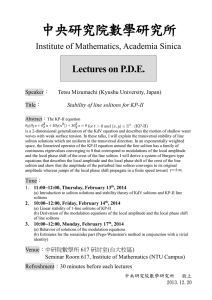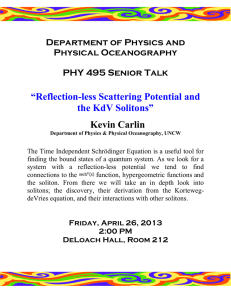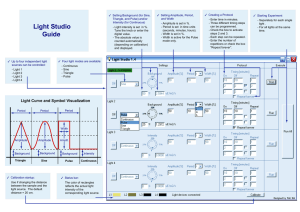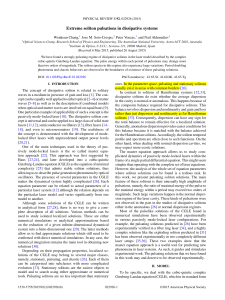Solitary Waves in Blood Vessels
advertisement
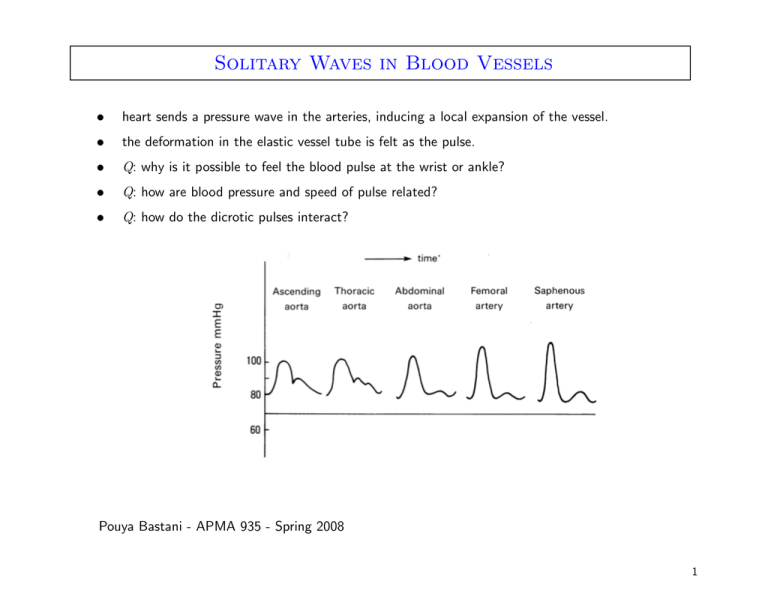
Solitary Waves in Blood Vessels • heart sends a pressure wave in the arteries, inducing a local expansion of the vessel. • the deformation in the elastic vessel tube is felt as the pulse. • Q: why is it possible to feel the blood pulse at the wrist or ankle? • Q: how are blood pressure and speed of pulse related? • Q: how do the dicrotic pulses interact? Pouya Bastani - APMA 935 - Spring 2008 1 Modelling Assumptions • blood is an incompressible fluid (constant fluid density ρ0 ) • the artery is an infinitely long circular elastic cylinder • there are no viscous effects • the flow is 1D – ie. localized pressure increase causes radially symmetric expansion 2 Modelling Fundamental Equations • conservation of mass • conservation of momentum • Newton’s second law ∂A ∂ + (Av) = 0 ∂t ∂x ∂v ∂v 1 ∂p +v =− ∂t ∂x ρ0 ∂x ∂ 2 r(x, t) ρR h l ds = l p(x, t) ds − 2Tc sin ∂t2 „ dθ 2 « ρR is the density of artery wall Simplifications • use sin(dθ/2) ≈ dθ/2 with dθ = ds/a and A − πa2 ≈ 2πr(r − a) where a is the equilibrium radius of the ring. Also introduce Young’s modulus E= • stress Tc 2πa = strain hl 2π(r − a) nondimensionalize 2 A → πa A p → (Eh/2a)p q x → x ρR ah/2ρ0 v→v t→ q q ρR a2 /Et Eh/2aρ0 3 Modelling Simplified Non-dimensional Equations At + (Av)x = 0 vt + vvx = −px p = (A − 1) + Att Linearization • ~ = (A, v, p) = (1, 0, 0) linearize about equilibrium values S Ãt + ṽx = 0 ṽt = −p̃x p̃ = Ã + Ãtt • use S~0 ei(kx−ωt) as the Ansatz, and require the determinant to vanish, giving 2 ω= k 1 + k2 !1 2 k3 ∼k− 2 k1 • k = 0 is the unset of instability • group velocity = 1 − k2 /2, so in the absence of nonlinearity the wave would disperse • 3 change variables to ξ = k(x − t) and τ = k3 t implied by eik(x−t)+itk /2 and perturb about the equilibrium solution (only even powers of k occur in the equations) p = k2 p1 + k4 p2 + · · · A = 1 + k 2 A1 + k 4 A2 + · · · v = k 2 v1 + k 4 v2 + · · · 4 Modelling Nonlinear Correction • O(k2 ) ∂A ∂v ∂v ∂p − ∂ξ1 + ∂ξ1 = 0 − ∂ξ1 + ∂ξ1 = 0 p1 = A1 this gives p1 = A1 = v1 + φ(τ ) where I take the arbitrary φ(τ ) ≡ 0 • O(k4 ) ∂A ∂A ∂v ∂ (A v ) + 2 − ∂ξ2 + ∂τ1 + ∂ξ 1 1 ∂ξ = 0 ∂v ∂v ∂v ∂p − ∂ξ2 + ∂τ1 + v1 ∂ξ1 = − ∂ξ2 ∂ 2A 1 p2 = A2 + 2 ∂ξ the equations can be combined to eliminate A2 , v2 , and p2 giving ∂p1 3 ∂p1 1 ∂ 3 p1 + p1 + =0 ∂τ 2 ∂ξ 2 ∂ξ 3 Korteweg-de Vries Equation • dropping the subscripts gives pτ + 32 ppξ + 21 pξξξ = 0 5 Modelling Soliton Solution • solitons travel unchanged in shape at speed c, so write p(ξ, τ ) = p(η) where η = ξ − cτ 3 0 1 000 0 −cp + pp + p = 0 2 2 • for a localized solution p, pξ , pξξξ → 0 as η → ±∞, so integration constants = 0 • integrate thrice to obtain 3 2 1 00 −cp + p + p = a1 = 0 4 2 1 3 1 0 2 1 2 − cp + p + (p ) = a2 = 0 2 4 4 2 p(τ, ξ) = 2c sech hq c 2 (ξ − cτ ) i 6 Interpretation Pressure Pulse • in the original variables 2s chE 2 p(x, t) = sech 4 a k2 cρ0 x− 2ahρR s 3 k2 cE 2 (1 + k c) t5 2 4a ρR • smoking → arteries become more rigid → E increases → blood pressure and speed increases • fat accumulation → thickness of artery wall h increases → pulse width & blood pressure increase Pressure vs. Velocity • 1 assuming φ(τ ) = 0, we have p1 = v1 so in the dimensional form T L = p0 p or to leading order r Ehρ0 v∼p 2a • for the femoral artery (a large one in the muscles of the thigh) of dogs 6 3 E ≈ 1.41 × 10 dyne/cm h ≈ 0.12 a vmax ≈ 500 cm/s 3 ρ0 ≈ 1.05 gr/cm so we predict that pmax ≈ 111 mmHg in close agreement with experimental value 110 mmHg • note: 1 dyne = 1 g · cm/s2 and 1mmHg ≈ 1333 g/(cm · s2 ) 7 Analysis Weakly Damped KdV • what happens to the pulse if weak (0 < 1) dissipation due to blood viscosity is included? Ut + 32 U Ux + 12 Uxxx + U = 0 Modulation Theory • expecting the amplitude to decay slowly with time, take c to be slowly varying U (x, t) = 2c(τ )V (η) 2 where V (η) = sech(η) , η = • q c(τ ) 0 2 (x − Ω(τ )), τ = t and Ω(τ ) = c(τ ). substitution gives " 0 c c0 0 + V + ηV = 0 c 2c # • multiply by V and integrate η ∈ (−∞, ∞) " #Z ∞ 3c0 2 V dη = 0 + 4c −∞ • since the integral = 2 we get c0 + 34 c = 0 and with φ(0) = 0 » – 4 t 3c0 −4 t − Ω(τ ) = c(τ ) = c0 e 3 1−e 3 4 8 Numerics Scheme • Fourth Order Runge-Kutta with FFT Integrating Factor Damped KdV • error = | numerical solution − asymptotic solution | averaged in space at time T = 0.1 • error convergence is O() • the soliton amplitude and speed drops as it evolves (expected from the analytical solution) 9 Analysis Higher Order Corrections • from error convergence, can expect asymptotic expansion c(τ ) = c0 (τ ) + c1 (τ ) + · · · • substitution into the equation yields – » – » 1 c1 c1 −1 0 0 −1 0 0 0 + c0 V + (c0 + c1 + · · ·)(1 + + · · ·) ηV = 0 (c0 + c1 + · · ·)(1 + + · · ·) c0 2 c0 • multiply by V and integrate as before • the first correction is • not really a correction, since we can include c1 in c0 • same happens with c2 , and so on → there is no polynomial correction!!! • can explain the apparent paradox by extending error convergence computation c00 4 c01 = =− c1 c0 3 10 Numerics Two-Soliton Interaction • arterial pulse is dicrotic: i.e. composed of a strong and weak pulse • solitons don’t change shape after interaction with one another • they slow down or speed up afterwards depending on their relative amplitude • u1 : single soliton with small amplitude u3 = u1 + u2 • larger amplitude solitons travel faster (speed ∝ amplitude) and have smaller width • steepening in arterial pulse wave coincides with the increase in pulse-wave velocity u2 : single soliton with large amplitude 11 References [1] G.L. Lamb. Elements of Soliton Theory. Wiley-Interscience Publication, John Wiley & Sons, Inc., 1980. [2] T. Dauxois, M. Peyrard. Physics of Solitons. Cambridge University Press, 2006. [3] S. Yomosa. “Solitary Waves in Large Blood Vessels.” Journal of the Physical society of Japan. February 1987, vol. 56, pp. 506-520. [4] H. Demiray. “A note on the solution of perturbed Korteweg-de Vries equation.” Applied Mathematics and Computation. November 2002, vol. 132, pp. 643-647 12
